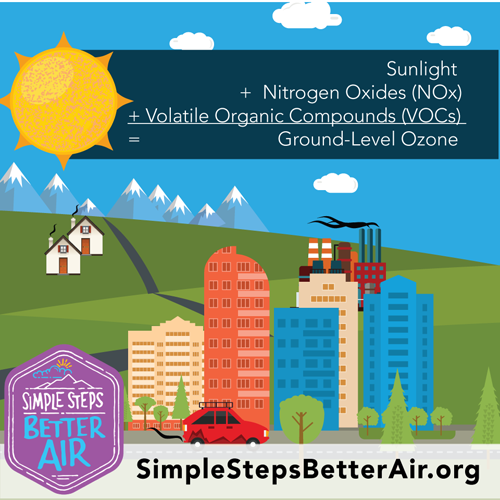 by Gabi Johnston| Office of Communications
by Gabi Johnston| Office of CommunicationsThe Colorado Department of Public Health and Environment is partnering with the Regional Air Quality Council in a summer campaign focused on getting Coloradans to do their part to reduce ground-level ozone.
For decades, the department’s Air Pollution Control Division has worked closely with businesses and residents to ensure Colorado’s air quality is the best it can be. Currently, Colorado meets the U.S. Environmental Protection Agency’s health-based standard for five of six criteria pollutants. It does not meet the standard for ground-level ozone.
When ozone is found high in the earth’s atmosphere, it’s helpful because it protects people from harmful radiation from the sun. Lower in the atmosphere, ozone is formed by the reaction of volatile organic compounds and nitrogen oxides with atmospheric oxygen in the presence of sunlight. High levels of ground-level ozone can cause health concerns for everyone, including people who exercise outdoors, the elderly, young children, and those with asthma or other respiratory problems.
Because ozone is formed when it is sunny outside, Colorado typically sees higher levels of ground-level ozone in the summer. The best way to reduce ground-level ozone is to reduce the pollutants that mix to create it: volatile organic compounds and nitrogen oxides. VOCs come from a number of sources, including industrial plants and factories, oil and gas development, paints, solvents, vehicles, lawn and garden equipment, and even sources such as plants and trees. NOx comes from industrial plants and factories, oil and gas development, and vehicles.
Numerous state programs and regulations have been in place for decades to work with businesses and industries that tend to contribute to ground-level ozone. In addition, Colorado has one of the most comprehensive mobile source programs in the country. That program oversees several efforts, including the state’s vehicle emissions program, Air Care Colorado, which helps keep 25 tons of excess pollutants out of Colorado’s air every day. Still, with the state’s population increase and the boom in new businesses and industries, the ozone levels remain at levels higher than state health department officials want to see.
With more than 4 million cars on the road in the Denver metro area every day, one of the more effective ways to reduce ground-level ozone is to get Coloradans to make simple changes in their driving habits.
“Vehicle emissions are a significant contributor to ground-level ozone,” said Doug Decker, manager of the Mobile Sources Program. “If each of us does just a little to reduce pollution, we could see a significant drop in our ground-level ozone numbers. That would improve air quality and public health, and it would enhance the outdoor lifestyle so many Coloradans embrace.”
That’s the goal of the Regional Air Quality Council’s “Simple Steps. Better Air.” program. You might see the campaign’s messages around metro Denver this summer on buses, billboards and social media, and hear its messages on Pandora radio. The program website, Simple Steps Better Air.org, provides information about ground-level ozone and how to reduce it. The website also includes the Ozo Meter, a special tool that allows you to see the positive impact your simple actions can have on our air.
“Everyone in this region can have a positive impact on our summer air quality,” said Sara Goodwin, communications director for the council. “One of the simplest ways is to combine or eliminate your car trips as much as possible. If just 10 percent of metro Denver drivers skipped or combined two car trips each week, that would take nearly 400,000 vehicles off metro area roads every day.”